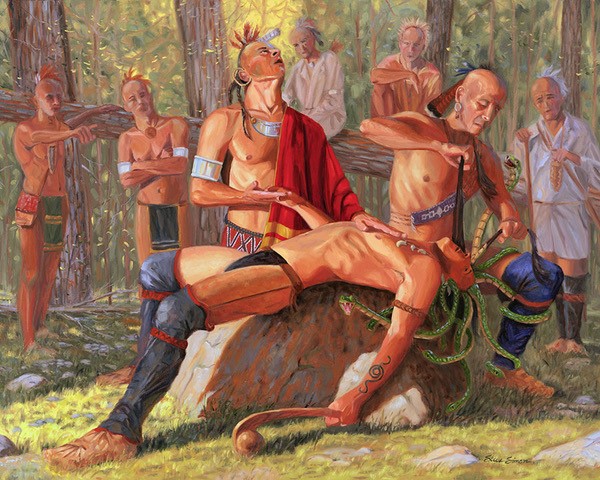A full rendition of this epic, which takes several days to tell, reveals the ways in which the Peacemaker’s teachings emphasized the power of Reason, not force, to assure the three principles of the Great Law: Righteousness, Justice, and Health. The Great Law of Peace provides the Haudenosaunee people with instructions on how to treat others, directs them on how to maintain a democratic society, and expresses how Reason must prevail in order to preserve peace. The following is an abbreviated version of the story.
Long ago, the Haudenosaunee Nations were at war with each other. A man called the Peacemaker wanted to spread peace and unity throughout Haudenosaunee territory. While on his journey, the Peacemaker came to the house of an Onondaga leader named Hayo’wetha (hi-an-WEN-ta), more commonly known as Hiawatha. Hayo’wetha believed in the message of peace and wanted the Haudenosaunee people to live in a united way. An evil Onondaga leader called Tadadaho, who hated the message of peace, had killed Hayo’wetha’s wife and daughters during the violent times. Tadadaho was feared by all; he was perceived as being so evil that his hair was comprised of writhing snakes, symbolizing his twisted mind.
The Peacemaker helped Hayo’wetha mourn his loss and ease his pain. Hayo’wetha then traveled with the Peacemaker to help unite the Haudenosaunee. The Peacemaker used arrows to demonstrate the strength of unity. First, he took a single arrow and broke it in half. Then he took five arrows and tied them together. This group of five arrows could not be broken. The Peacemaker said, “A single arrow is weak and easily broken. A bundle of arrows tied together cannot be broken. This represents the strength of having a confederacy. It is strong and cannot be broken.” The Mohawk, Oneida, Cayuga, Seneca, and Onondaga accepted the message of peace.
With the nations joined together, the Peacemaker and Hayo’wetha sought out Tadadaho. As they approached Tadadaho, he resisted their invitation to join them. The Peacemaker promised Tadadaho that if he accepted the message of peace, Onondaga would be the capital of the Grand Council. Tadadaho finally succumbed to the message of peace. It is said that the messengers of peace combed the snakes from his hair. The name Hayo’we:tha means “he who combs,” indicating his role in convincing Tadadaho to accept the Great Law of Peace. Joined together, these five nations became known as the Haudenosaunee Confederacy.
When peace had successfully been spread among the five nations, the people gathered together to celebrate. They uprooted a white pine tree and threw their weapons into the hole. They replanted the tree on top of the weapons and named it the Tree of Peace, which symbolizes the Great Law of Peace that the Haudenosaunee came to live by. The four main roots of the Tree of Peace represent the four directions and the paths of peace that lead to the heart of Haudenosaunee territory, where all who want to follow the Great Law of Peace are welcome. At the top of the Tree of Peace is an eagle, guardian of the Haudenosaunee and messenger to the Creator.
One of the most important events that shaped the Haudenosaunee was the creation of the Gayanesshagowa (gaya-ness-HA-gowa), the Great Law of Peace. It guides the Haudenosauneethrough all aspects of life.

